2000 MERCEDES-BENZ SLK CLASS transmission
[x] Cancel search: transmissionPage 153 of 273
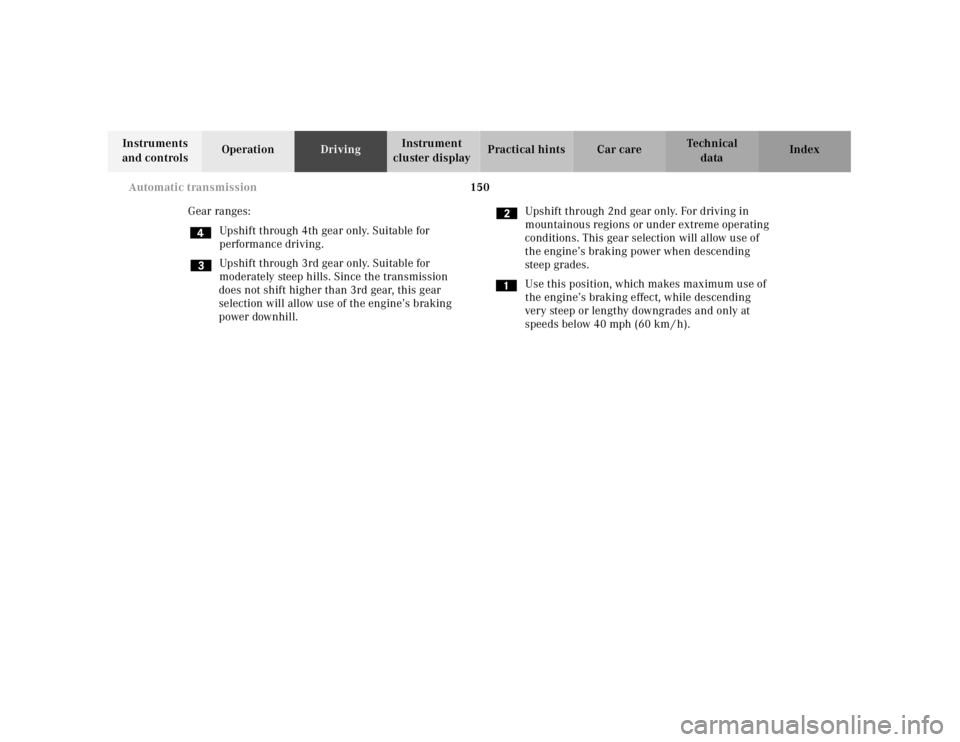
150 Automatic transmission
Te ch n ica l
data Instruments
and controlsOperationDrivingInstrument
cluster displayPractical hints Car care Index
Gear ranges:
Upshift through 4th gear only. Suitable for
performance driving.
Upshift through 3rd gear only. Suitable for
moderately steep hills. Since the transmission
does not shift higher than 3rd gear, this gear
selection will allow use of the engine’s braking
power downhill.Upshift through 2nd gear only. For driving in
mountainous regions or under extreme operating
conditions. This gear selection will allow use of
the engine’s braking power when descending
steep grades.
Use this position, which makes maximum use of
the engine’s braking effect, while descending
very steep or lengthy downgrades and only at
speeds below 40 mph (60 km / h).
Page 154 of 273
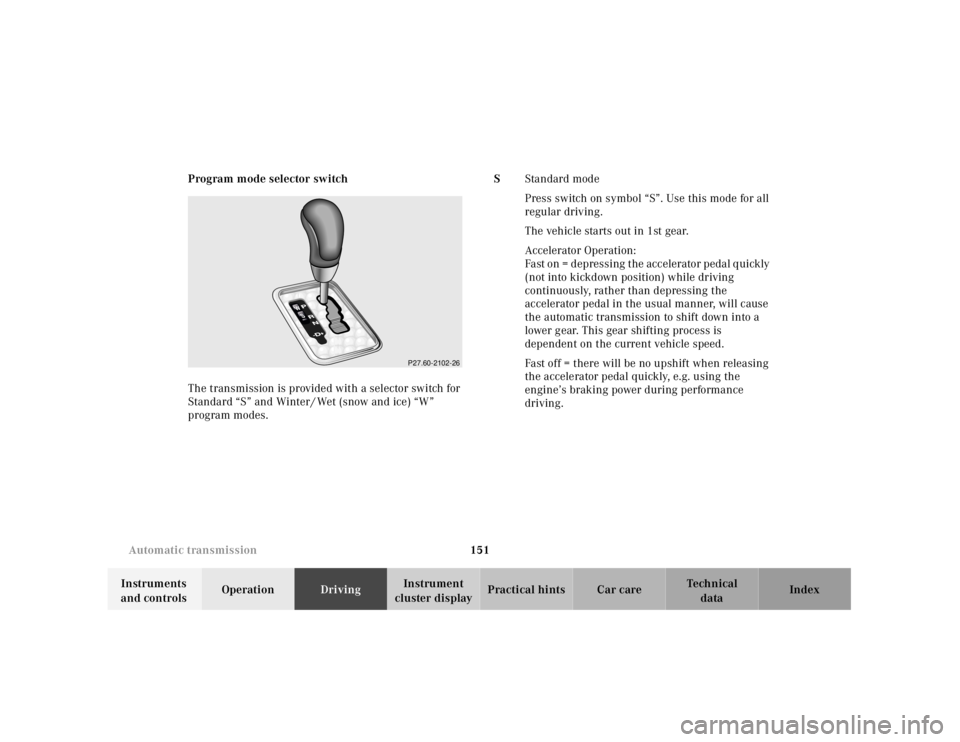
151 Automatic transmission
Te ch n ica l
data Instruments
and controlsOperationDrivingInstrument
cluster displayPractical hints Car care Index Program mode selector switch
The transmission is provided with a selector switch for
Standard “S” and Winter / Wet (snow and ice) “W”
program modes.SStandard mode
Press switch on symbol “S”. Use this mode for all
regular driving.
The vehicle starts out in 1st gear.
Accelerator Operation:
Fa st o n = d e p re s s i ng t h e a c c e l e r a to r p e d a l q u i ck ly
(not into kickdown position) while driving
continuously, rather than depressing the
accelerator pedal in the usual manner, will cause
the automatic transmission to shift down into a
lower gear. This gear shifting process is
dependent on the current vehicle speed.
Fast off = there will be no upshift when releasing
the accelerator pedal quickly, e.g. using the
engine’s braking power during performance
driving.
�� @@
€€
ÀÀ
��
@@
€€
ÀÀ
��
@@
€€
ÀÀ
��
@@
€€
ÀÀ
��
@@
€€
ÀÀ
��
@@
€€
ÀÀ
��
@@
€€
ÀÀ
��
@@
€€
ÀÀ
��
@@
€€
ÀÀ
��
@@
€€
ÀÀ
��
@@
€€
ÀÀ
��
@@
€€
ÀÀ
��
@@
€€
ÀÀ
��
@@
€€
ÀÀ
��
@@
€€
ÀÀ
��
@@
€€
ÀÀ
��
@@
€€
ÀÀ
��
@@
€€
ÀÀ
��
@@
€€
ÀÀ
��
@@
€€
ÀÀ
��
@@
€€
ÀÀ
��
@@
€€
ÀÀ
��
@@
€€
ÀÀ
��
@@
€€
ÀÀ
��
@@
€€
ÀÀ
��
@@
€€
ÀÀ
��
@@
€€
ÀÀ
��
@@
€€
ÀÀ
��
@@
€€
ÀÀ
��
@@
€€
ÀÀ
��
@@
€€
ÀÀ
��
@@
€€
ÀÀ
��
@@
€€
ÀÀ
��
@@
€€
ÀÀ
��
@@
€€
ÀÀ
��
@@
€€
ÀÀ
��
@@
€€
ÀÀ
��
@@
€€
ÀÀ
��
@@
€€
ÀÀ
��
@@
€€
ÀÀ
��
@@
€€
ÀÀ
��
@@
€€
ÀÀ
��
@@
€€
ÀÀ
��
@@
€€
ÀÀ
��
@@
€€
ÀÀ
��
@@
€€
ÀÀ
��
@@
€€
ÀÀ
��
@@
€€
ÀÀ
��
@@
€€
ÀÀ
��
@@
€€
ÀÀ
��
@@
€€
ÀÀ
��
@@
€€
ÀÀ
��
@@
€€
ÀÀ
��
@@
€€
ÀÀ
��
@@
€€
ÀÀ
��
@@
€€
ÀÀ
��
@@
€€
ÀÀ
��
@@
€€
ÀÀ
��
@@
€€
ÀÀ
��
@@
€€
ÀÀ
��
@@
€€
ÀÀ
��
@@
€€
ÀÀ
��
@@
€€
ÀÀ
��
@@
€€
ÀÀ
��
@@
€€
ÀÀ
��
@@
€€
ÀÀ
��
@@
€€
ÀÀ
��
@@
€€
ÀÀ
��
@@
€€
ÀÀ
��
@@
€€
ÀÀ
��
@@
€€
ÀÀ
��
@@
€€
ÀÀ
��
@@
€€
ÀÀ
��
@@
€€
ÀÀ
��
@@
€€
ÀÀ
��
@@
€€
ÀÀ
��
@@
€€
ÀÀ
��
@@
€€
ÀÀ
��
@@
€€
ÀÀ
��
@@
€€
ÀÀ
��
@@
€€
ÀÀ
��
@@
€€
ÀÀ
��
@@
€€
ÀÀ
��
@@
€€
ÀÀ
��
@@
€€
ÀÀ
��
@@
€€
ÀÀ
��
@@
€€
ÀÀ
��
@@
€€
ÀÀ
��
@@
€€
ÀÀ
��
@@
€€
ÀÀ
��
@@
€€
ÀÀ
��
@@
€€
ÀÀ
��
@@
€€
ÀÀ
��
@@
€€
ÀÀ
��
@@
€€
ÀÀ
��
@@
€€
ÀÀ
��
@@
€€
ÀÀ
��
@@
€€
ÀÀ
��
@@
€€
ÀÀ
��
@@
€€
ÀÀ
��
@@
€€
ÀÀ
��
@@
€€
ÀÀ
��
@@
€€
ÀÀ
��
@@
€€
ÀÀ
��
@@
€€
ÀÀ
��
@@
€€
ÀÀ
��
@@
€€
ÀÀ
��
@@
€€
ÀÀ
��
@@
€€
ÀÀ
��
@@
€€
ÀÀ
��
@@
€€
ÀÀ
��
@@
€€
ÀÀ
��
@@
€€
ÀÀ
��
@@
€€
ÀÀ
��
@@
€€
ÀÀ
��
@@
€€
ÀÀ
��
@@
€€
ÀÀ
��
@@
€€
ÀÀ
��
@@
€€
ÀÀ
��
@@
€€
ÀÀ
��
@@
€€
ÀÀ
��
@@
€€
ÀÀ
��
@@
€€
ÀÀ
��
@@
€€
ÀÀ
��
@@
€€
ÀÀ
��
@@
€€
ÀÀ
��
@@
€€
ÀÀ
��
@@
€€
ÀÀ
��
@@
€€
ÀÀ
��
@@
€€
ÀÀ
��
@@
€€
ÀÀ
��
@@
€€
ÀÀ
��
@@
€€
ÀÀ
��
@@
€€
ÀÀ
��
@@
€€
ÀÀ
��
@@
€€
ÀÀ
��
@@
€€
ÀÀ
��
@@
€€
ÀÀ
��
@@
€€
ÀÀ
��
@@
€€
ÀÀ
��
@@
€€
ÀÀ
��
@@
€€
ÀÀ
��
@@
€€
ÀÀ
��
@@
€€
ÀÀ
��
@@
€€
ÀÀ
��
@@
€€
ÀÀ
��
@@
€€
ÀÀ
��
@@
€€
ÀÀ
��
@@
€€
ÀÀ
��
@@
€€
ÀÀ
��
@@
€€
ÀÀ
��
@@
€€
ÀÀ
��
@@
€€
ÀÀ
��
@@
€€
ÀÀ
��
@@
€€
ÀÀ
��
@@
€€
ÀÀ
��
@@
€€
ÀÀ
��
@@
€€
ÀÀ
��
@@
€€
ÀÀ
��
@@
€€
ÀÀ
��
@@
€€
ÀÀ
��
@@
€€
ÀÀ
��
@@
€€
ÀÀ
��
@@
€€
ÀÀ
��
@@
€€
ÀÀ
��
@@
€€
ÀÀ
��
@@
€€
ÀÀ
��
@@
€€
ÀÀ
��
@@
€€
ÀÀ
��
@@
€€
ÀÀ
��
@@
€€
ÀÀ
��
@@
€€
ÀÀ
��
@@
€€
ÀÀ
��
@@
€€
ÀÀ
��
@@
€€
ÀÀ
��
@@
€€
ÀÀ
��
@@
€€
ÀÀ
��
@@
€€
ÀÀ
��
@@
€€
ÀÀ
��
@@
€€
ÀÀ
��
@@
€€
ÀÀ
��
@@
€€
ÀÀ
��
@@
€€
ÀÀ
��
@@
€€
ÀÀ
��
@@
€€
ÀÀ
��
@@
€€
ÀÀ
��
@@
€€
ÀÀ
��
@@
€€
ÀÀ
��
@@
€€
ÀÀ
��
@@
€€
ÀÀ
��
@@
€€
ÀÀ
��
@@
€€
ÀÀ
��
@@
€€
ÀÀ
��
@@
€€
ÀÀ
��
@@
€€
ÀÀ
��
@@
€€
ÀÀ
��
@@
€€
ÀÀ
��
@@
€€
ÀÀ
��
@@
€€
ÀÀ
��
@@
€€
ÀÀ
��
@@
€€
ÀÀ
��
@@
€€
ÀÀ
��
@@
€€
ÀÀ
��
@@
€€
ÀÀ
��
@@
€€
ÀÀ
��
@@
€€
ÀÀ
��
@@
€€
ÀÀ
��
@@
€€
ÀÀ
��
@@
€€
ÀÀ
��
@@
€€
ÀÀ
��
@@
€€
ÀÀ
��
@@
€€
ÀÀ
��
@@
€€
ÀÀ
��
@@
€€
ÀÀ
��
@@
€€
ÀÀ
��
@@
€€
ÀÀ
��
@@
€€
ÀÀ
��
@@
€€
ÀÀ
��
@@
€€
ÀÀ
��
@@
€€
ÀÀ
��
@@
€€
ÀÀ
��
@@
€€
ÀÀ
��
@@
€€
ÀÀ
��
@@
€€
ÀÀ
��
@@
€€
ÀÀ
��
@@
€€
ÀÀ
��
@@
€€
ÀÀ
��
@@
€€
ÀÀ
��
@@
€€
ÀÀ
��
@@
€€
ÀÀ
��
@@
€€
ÀÀ
��
@@
€€
ÀÀ
��
@@
€€
ÀÀ
��
@@
€€
ÀÀ
��
@@
€€
ÀÀ
��
@@
€€
ÀÀ
��
@@
€€
ÀÀ
��
@@
€€
ÀÀ
��
@@
€€
ÀÀ
��
@@
€€
ÀÀ
��
@@
€€
ÀÀ
��
@@
€€
ÀÀ
��
@@
€€
ÀÀ
��
@@
€€
ÀÀ
��
@@
€€
ÀÀ
��
@@
€€
ÀÀ
��
@@
€€
ÀÀ
��
@@
€€
ÀÀ
��
@@
€€
ÀÀ
��
@@
€€
ÀÀ
��
@@
€€
ÀÀ
��
@@
€€
ÀÀ
��
@@
€€
ÀÀ
��
@@
€€
ÀÀ
��
@@
€€
ÀÀ
��
@@
€€
ÀÀ
��
@@
€€
ÀÀ
��
@@
€€
ÀÀ
��
@@
€€
ÀÀ
��
@@
€€
ÀÀ
��
@@
€€
ÀÀ
��
@@
€€
ÀÀ
��
@@
€€
ÀÀ
��
@@
€€
ÀÀ
��
@@
€€
ÀÀ
��
@@
€€
ÀÀ
��
@@
€€
ÀÀ
��
@@
€€
ÀÀ
��
@@
€€
ÀÀ
��
@@
€€
ÀÀ
��
@@
€€
ÀÀ
��
@@
€€
ÀÀ
��
@@
€€
ÀÀ
��
@@
€€
ÀÀ
��
@@
€€
ÀÀ
��
@@
€€
ÀÀ
��
@@
€€
ÀÀ
��
@@
€€
ÀÀ
��
@@
€€
ÀÀ
��
@@
€€
ÀÀ
��
@@
€€
ÀÀ
��
@@
€€
ÀÀ
��
@@
€€
ÀÀ
��
@@
€€
ÀÀ
��
@@
€€
ÀÀ
��
@@
€€
ÀÀ
��
@@
€€
ÀÀ
��
@@
€€
ÀÀ
��
@@
€€
ÀÀ
��
@@
€€
ÀÀ
��
@@
€€
ÀÀ
��
@@
€€
ÀÀ
��
@@
€€
ÀÀ
��
@@
€€
ÀÀ
��
@@
€€
ÀÀ
��
@@
€€
ÀÀ
��
@@
€€
ÀÀ
��
@@
€€
ÀÀ
��
@@
€€
ÀÀ
��
@@
€€
ÀÀ
��
@@
€€
ÀÀ
��
@@
€€
ÀÀ
��
@@
€€
ÀÀ
��
@@
€€
ÀÀ
��
@@
€€
ÀÀ
��
@@
€€
ÀÀ
��
@@
€€
ÀÀ
��
@@
€€
ÀÀ
��
@@
€€
ÀÀ
��
@@
€€
ÀÀ
��
@@
€€
ÀÀ
��
@@
€€
ÀÀ
��
@@
€€
ÀÀ
��
@@
€€
ÀÀ
��
@@
€€
ÀÀ
��
@@
€€
ÀÀ
��
@@
€€
ÀÀ
��
@@
€€
ÀÀ
��
@@
€€
ÀÀ
��
@@
€€
ÀÀ
��
@@
€€
ÀÀ
��
@@
€€
ÀÀ
��
@@
€€
ÀÀ
��
@@
€€
ÀÀ
��
@@
€€
ÀÀ
��
@@
€€
ÀÀ
��
@@
€€
ÀÀ
��
@@
€€
ÀÀ
��
@@
€€
ÀÀ
��
@@
€€
ÀÀ
��
@@
€€
ÀÀ
��
@@
€€
ÀÀ
��
@@
€€
ÀÀ
��
@@
€€
ÀÀ
��
@@
€€
ÀÀ
��
@@
€€
ÀÀ
��
@@
€€
ÀÀ
��
@@
€€
ÀÀ
��
@@
€€
ÀÀ
��
@@
€€
ÀÀ
��
@@
€€
ÀÀ
��
@@
€€
ÀÀ
��
@@
€€
ÀÀ
��
@@
€€
ÀÀ
��
@@
€€
ÀÀ
��
@@
€€
ÀÀ
��
@@
€€
ÀÀ
��
@@
€€
ÀÀ
��
@@
€€
ÀÀ
��
@@
€€
ÀÀ
��
@@
€€
ÀÀ
��
@@
€€
ÀÀ
��
@@
€€
ÀÀ
��
@@
€€
ÀÀ
��
@@
€€
ÀÀ
��
@@
€€
ÀÀ
��
@@
€€
ÀÀ
��
@@
€€
ÀÀ
��
@@
€€
ÀÀ
��
@@
€€
ÀÀ
��
@@
€€
ÀÀ
��
@@
€€
ÀÀ
��
@@
€€
ÀÀ
��
@@
€€
ÀÀ
��
yy
P27.60-2102-26
Page 155 of 273

152 Automatic transmission
Te ch n ica l
data Instruments
and controlsOperationDrivingInstrument
cluster displayPractical hints Car care Index
WWinter / Wet (snow and ice) mode
Press switch on symbol “W”. The vehicle starts
out in 2nd gear, except with selector lever in 1st
gear, or with accelerator pedal in kick-down
position.
The “W” mode helps to improve traction and
driving stability of the vehicle.
The gear shifting process occurs at lower vehicle
and engine speeds than in the “S” program mode.
Caution!
Never change the program mode when the selector lever
is out of position “P”. It could result in a change of
driving characteristics for which you may not be
prepared.
Important!
Always be certain of the program mode selected since
the vehicle driving characteristics change with the
selection of the program mode.
Dependent on the program mode selector switch
position “S” or “W” and the gear selector lever in
position “R”, the ratio of power transmission changes.Emergency Operation
(Limp Home Mode)
If vehicle acceleration worsens, or the transmission no
longer shifts, the transmission is most likely operating
in Limp Home Mode which engages when there is a
malfunction of the transmission. This condition may be
accompanied by the “CHECK ENGINE” malfunction
indicator lamp in the instrument cluster coming on.
In this mode only the 2nd gear or reverse gear can be
activated.
To engage 2nd gear or reverse:
1.Stop the vehicle.
2.Move selector lever to position “P”.
3.Turn off the engine.
4.Wait approximately 10 seconds.
5.Restart the engine.
6.Move sel ector lever to position “D” (for 2nd gear), or
move selector lever to position “R” (for reverse gear).
Have the transmission checked at your authorized
Mercedes-Benz Center as soon as possible.
Page 159 of 273
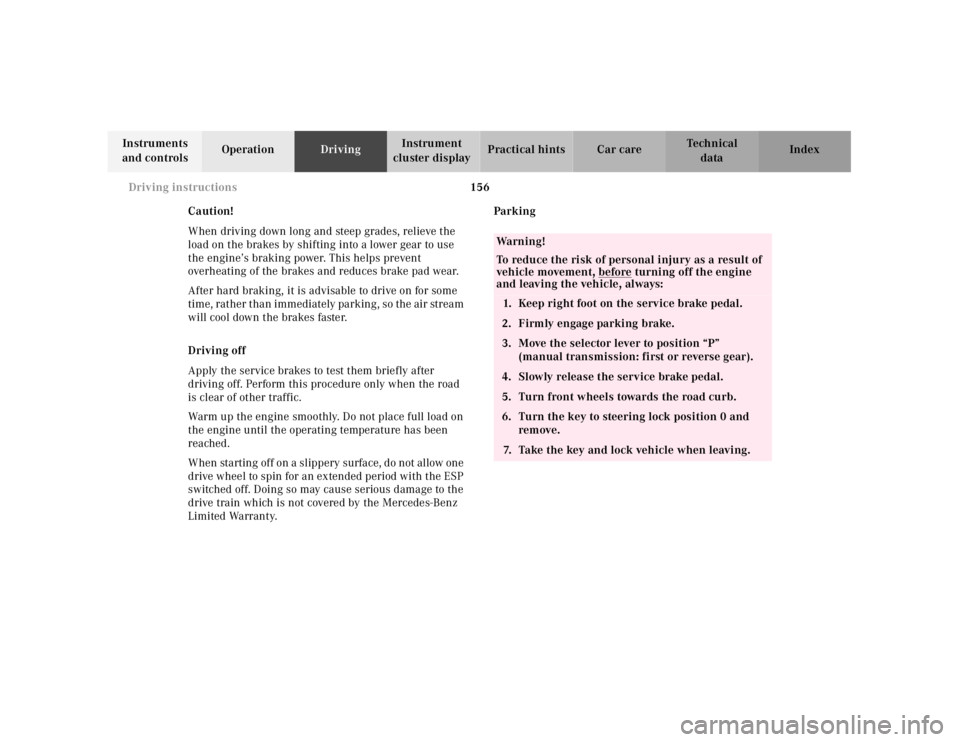
156 Driving instructions
Te ch n ica l
data Instruments
and controlsOperationDrivingInstrument
cluster displayPractical hints Car care Index
Caution!
When driving down long and steep grades, relieve the
load on the brakes by shifting into a lower gear to use
the engine’s braking power. This helps prevent
overheating of the brakes and reduces brake pad wear.
After hard braking, it is advisable to drive on for some
time, rather than immediately parking, so the air stream
will cool down the brakes faster.
Driving off
Apply the service brakes to test them briefly after
driving off. Perform this procedure only when the road
is clear of other traffic.
Warm up the engine smoothly. Do not place full load on
the engine until the operating temperature has been
reached.
W hen sta rting of f on a sl ippery surfa ce, d o not al low one
drive wheel to spin for an extended period with the ESP
switched off. Doing so may cause serious damage to the
drive train which is not covered by the Mercedes-Benz
Limited Warranty.Parking
Wa r n i n g !
To reduce the risk of personal injury as a result of
vehicle movement, before
turning off the engine
and leaving the vehicle, always:
1. Keep right foot on the service brake pedal.
2. Firmly engage parking brake.
3. Move the selector lever to position “P”
(manual transmission: first or reverse gear).
4. Slowly release the service brake pedal.
5. Turn front wheels towards the road curb.
6. Turn the key to steering lock position 0 and
remove.
7. Take the key and lock vehicle when leaving.
Page 160 of 273
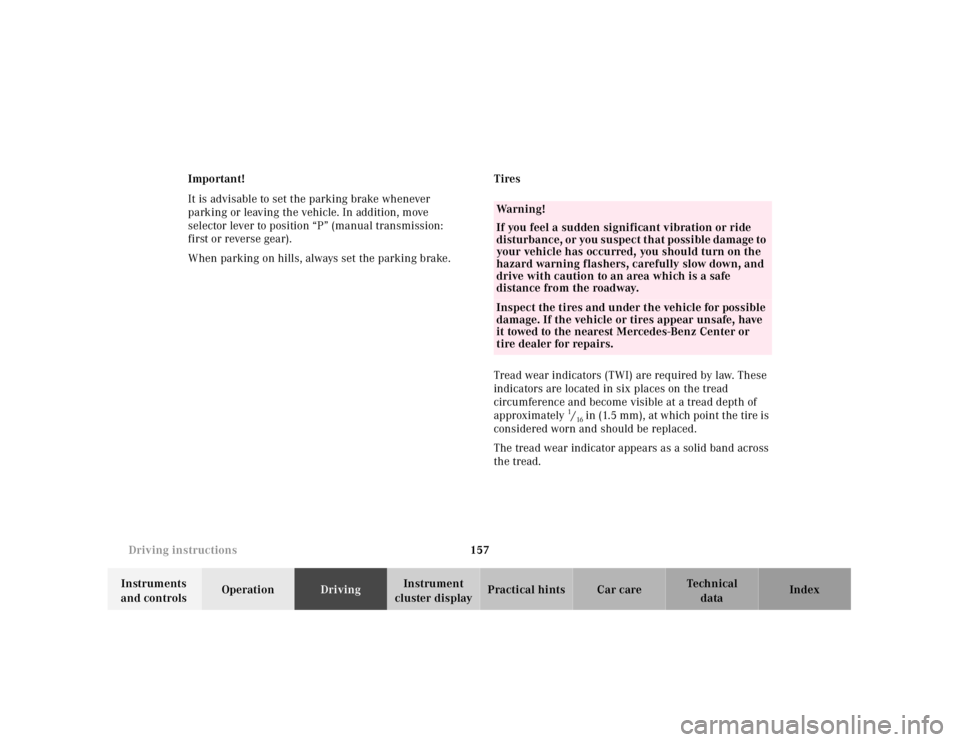
157 Driving instructions
Te ch n ica l
data Instruments
and controlsOperationDrivingInstrument
cluster displayPractical hints Car care Index Important!
It is advisable to set the parking brake whenever
parking or leaving the vehicle. In addition, move
selector lever to position “P” (manual transmission:
first or reverse gear).
When parking on hills, always set the parking brake.Tires
Tread wear indicators (TWI) are required by law. These
indicators are located in six places on the tread
circumference and become visible at a tread depth of
approximately
1/16 in (1.5 mm), at w hich point t he tire is
considered worn and should be replaced.
The tread wear indicator appears as a solid band across
the tread.
Wa r n i n g !
If you feel a sudden significant vibration or ride
disturbance, or you suspect that possible damage to
your vehicle has occurred, you should turn on the
hazard warning flashers, carefully slow down, and
drive with caution to an area which is a safe
distance from the roadway.Inspect the tires and under the vehicle for possible
damage. If the vehicle or tires appear unsafe, have
it towed to the nearest Mercedes-Benz Center or
tire dealer for repairs.
Page 163 of 273

160 Driving instructions
Te ch n ica l
data Instruments
and controlsOperationDrivingInstrument
cluster displayPractical hints Car care Index
Snow chains
Use only snow chains that are tested and recommended
by Mercedes-Benz. Your authorized Mercedes-Benz
Center will be glad to advise you on this subject.
Chains should only be used on the rear wheels. Follow
the manufacturer’s mounting instructions.
Snow chains should only be driven on snow covered
roads at speeds not to exceed 30 mph (50 km / h).
Remove chains as soon as possible when driving on
roads without snow.
When driving with snow chains, press the ESP control
switch to OFF, see page 172.
Important!
Use of snow chains is not permissible with tire size
225 / 50 R 16, with th e col lapsib le spa re tire, or with tire
size 245 / 40 ZR 17 (Sport Package).Winter driving instructions
The most important rule for slippery or icy roads is to
drive sensibly and to avoid abrupt acceleration, braking
and steering maneuvers. Do not use the cruise control
system under such conditions.
When the vehicle is in danger of skidding, move
selector lever to position “N” or in case of manual
transmission declutch. Try to keep the vehicle under
control by corrective steering action.
Road salts and chemicals can adversely affect braking
efficiency. Increased pedal force may become necessary
to produce the normal brake effect. We therefore
recommend depressing the brake pedal periodically
when traveling at length on salt-strewn roads. This can
bring road salt impaired braking efficiency back to
normal. A prerequisite is, however, that this be done
without endangering other drivers on the road.
If t he veh icle is pa rked af te r b eing driven on sal t trea ted
road s, th e braking ef f ic iency should be tested as soon a s
possible after driving is resumed while observing the
safety rules in the previous paragraph.
Page 165 of 273
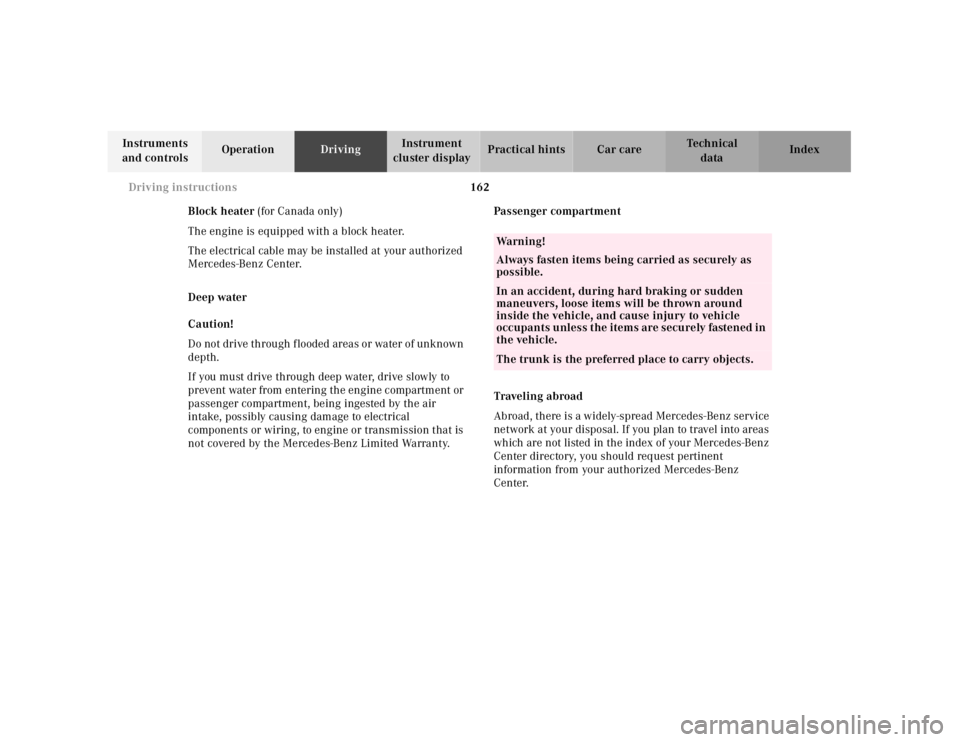
162 Driving instructions
Te ch n ica l
data Instruments
and controlsOperationDrivingInstrument
cluster displayPractical hints Car care Index
Block heater (for Canada only)
The engine is equipped with a block heater.
The electrical cable may be installed at your authorized
Mercedes-Benz Center.
Deep water
Caution!
D o not drive th rou gh f looded area s or wa ter of unknown
depth.
If you must drive through deep water, drive slowly to
prevent water from entering the engine compartment or
passenger compartment, being ingested by the air
intake, possibly causing damage to electrical
components or wiring, to engine or transmission that is
not covered by the Mercedes-Benz Limited Warranty.Passenger compartment
Traveling abroad
Abroad, there is a widely-spread Mercedes-Benz service
network at your disposal. If you plan to travel into areas
which are not listed in the index of your Mercedes-Benz
Center directory, you should request pertinent
information from your authorized Mercedes-Benz
Center.
Wa r n i n g !
Always fasten items being carried as securely as
possible.In an accident, during hard braking or sudden
maneuvers, loose items will be thrown around
inside the vehicle, and cause injury to vehicle
occupants unless the items are securely fastened in
the vehicle.The trunk is the preferred place to carry objects.
Page 168 of 273

165 Driving systems
Te ch n ica l
data Instruments
and controlsOperationDrivingInstrument
cluster displayPractical hints Car care IndexNotes:
If the engine does not brake the vehicle sufficiently
while driving on a downgrade, the speed you set on the
cruise control may be exceeded. In this case the
following will assist in maintaining the set cruise
controlled speed:
Vehicles with automatic transmission:
Downshift occurs (max. to 3rd gear) to maintain the set
cruise controlled speed by using the engine’s braking
power.
As soon as the grade eases, the automatic transmission
shifts up again dependent on the selector lever position.
Vehicles with manual transmission:
The set cruise controlled speed is switched off when
decl utch ing exceed s fou r se conds during d ow nsh if ting a
gear.
Neverth eless, in some ca ses you m ay have to step on t he
bra ke peda l to slow d ow n. In t his ca se th e cruise control
is switched off.
Use the lever to resume the previously set speed.
Wa r n i n g !
Only use the cruise control if the traffic and
weather conditions make it advisable to travel at a
steady speed.
• The use of cruise control can be dangerous on
winding roads or in heavy traffic because
conditions do not allow safe driving at a steady
speed.• The use of cruise control can be dangerous on
slippery roads. Rapid changes in tire adhesion
can result in wheel spin and loss of control.The “Resume” function should only be operated if
the driver is fully aware of the previously set speed
and wishes to resume this particular preset speed.